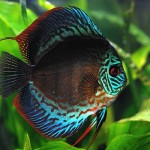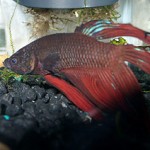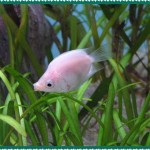Piranha are members of the Serrasalminae sub-family of Characins. The Characins is the group of fish, primarily from South America and Africa, that is best known as the Tetras. The Serrasalminae sub-family of Tetras contains the Piranha and their close cousin, the Pacu. These fish are from South America and have many similarities in both appearance and behavior.
Piranha are generally large fish, though most species of Piranha are not nearly as large as most species of Pacu. Smaller species or Piranha reach around four inches (10 centimeters) in length and larger species grow to about twelve inches (30cm).
Piranha generally live for four to fifteen years, depending on the species and quality of care given (larger varieties tend to live longer).
Piranhas have an undeserved bad reputation. They are unlikely to attack a large animal, like a human, unless they feel threatened or trapped, or are starving. However, possessing, keeping, trading, selling or harboring Piranha is illegal in some areas. Make sure you know the legal status of Piranha in your area before you purchase a Piranha.
Piranha Equipment & Maintenance:
To keep your Piranha healthy, first provide them with plenty of clean, warm water. Your Piranha’s temperature should be about 80° Fahrenheit (about 26.5° Celsius), and ideally should remain between 76° and 83° F (24.5° and 28.5° C) so you need a heater and a thermometer. Keeping your Piranha too warm for long periods of time will result in Oxygen deprivation, which can cause nerve damage, heart damage, and can seriously hamper the immune system. Keeping them too cool or exposing them to sudden chill can also hamper their immune system. An impaired immune system makes them more susceptible to many diseases, from easily treatable Ick to more difficult diseases such as dropsy or mouthrot.
Keep your Piranha in a fish tank of at least 2 gallons capacity per inch of mature fish length (about 8 liters per 2.5cm), this provides sufficient space for your Piranha so he can remain healthy, and this allows the fish tank to help you keep healthy fish. I recommend a minimum of 25 gallons (95 liters) for a Piranha aquarium, though larger varieties or multiple fish will mandate a larger fish tank.
Piranha are very messy fish, so aquarium maintenance is paramount. Perform your weekly 10-15% water changes, so that your Piranha always has clean water and any waste that is not processed by your aquarium filter is removed.
Your Piranha needs good filtration to keep the water from becoming toxic, and you need to keep the filter(s) well maintained. When selecting a filter, remember to make sure that the filter provides sufficient filtration for a fish tank with the large capacity that your Piranha require. Many people use multiple smaller filters to maintain a large fish tank like this. Using several smaller filters allows you to stagger your filter maintenance so that you are not changing all of your filter media at once and risking cycling your aquarium again. Remember, it is very important that your filters provide sufficient filtration for your total aquarium volume.
Piranha Food & Care:
Remember that your Piranha is omnivorous (eats anything), so provide him with a varied diet. Many high quality processed fish foods are available on the market today, and most frozen fish foods are also appropriate. In the wild, most Piranha eat primarily fins and scales of other large fish, only opportunistically scavenging on an old carcass, and only seasonally consuming large quantities of vegetable matter, so you are best off to try to duplicate this in the aquarium environment.
Provide a wide variety of processed, frozen, and freeze dried foods and occasionally offer the Piranha fresh green vegetables, such as sliced raw zucchini, spinach, and pieces of raw potato. Your fish should be able to consume all the food you offer within two minutes of feeding (the exception to this being fresh vegetables, which can be left for several hours before starting to decay). If there is food in your fish tank after this time has elapsed, this contributes to poor water quality and make your Piranha more susceptible to disease.
Though Piranha will take live foods, feeding live goldfish is always a bad idea. Feeder goldfish are not a very nutritious food, and they are a good way to spread disease to your beloved Piranha.
You only need to feed your Piranha once a day. If you feed more than once a day you increase the waste your fish are producing and also increase the risk of overfeeding, so it becomes more important that you are performing your weekly 10-15% water changes and all necessary filter maintenance. Providing a proper diet increases your Piranha’s life expectancy and bolsters their immune system.
Piranha, like any fish, are aware that they are prey animals. In fact, this flightiness is the most likely cause of an attack by a pet Piranha on its owner!
In order to feel comfortable, they need to have lots of hiding places. Piranha do not seem to be too particular about their cover, however, you do want to make sure that you do not use any sharp or rough decorations that your fish may get hurt on, in case your fish dart into them when startled. Like most other fish, they are more comfortable and will come out more and be more active if you can provide them with 50-75% cover – this means you should make half to three fourths of your aquarium space hiding places. Remember, if you use live plants to decorate your Piranha tank, you may have fish grazing on the plants.
Providing sufficient cover reduces stress and therefore improves your Piranha’s immune system, reducing chance of disease.
Piranha Companionship:
Piranha have odd companionship requirements. As juveniles, Piranhas are schooling fish, and should be kept in groups. However, as they mature, many varieties of Piranhas become more solitary, and may attack others of the same species. Frequently, Piranhas can be kept with small, peaceful fish such as neon Tetras and guppies, provided that the Piranha is large enough and has been kept on a high quality diet so as not to consider these fish as food. In a large enough aquarium, Piranhas can be kept with other larger fish, and the Piranhas will occasionally take a bite of a fin, but should leave the other fish alone.
Finally:
Remember, Piranhas are beautiful living creatures. It is the responsibility of the pet owner to care for their pet and provide a healthy environment. So give your Piranha space, clean, warm water, plenty of hiding places, and high-quality, highly varied foods and he should be a good companion for a long time. Treat your Piranha with respect, and his impressive teeth should never pose a threat.

















hi author,
reading your post made me get to know piranhas in general. Unlike our usual perception, piranhas can be a great pet that people could try having. Howver, certaion considerations must be observed in order to provide protection and security to the pet fish and its owner.